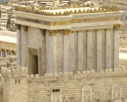 from The
Temple (1633), George Herbert:
from The
Temple (1633), George Herbert:
 from The
Temple (1633), George Herbert:
from The
Temple (1633), George Herbert:
¶ Church-monuments.
WHile that my soul repairs to her devotion, Here I intombe my flesh,1 that it betimes May take acquaintance of this heap of dust; To which the blast of deaths incessant motion, Fed with the exhalation of our crimes, Drives all at last. Therefore I gladly trust My bodie to this school, that it may learn To spell his elements, and finde his birth Written in dustie heraldrie and lines; Which dissolution sure doth best discern, Comparing dust with dust, and earth with earth. These laugh at Jeat and Marble put for signes, To sever the good fellowship of dust, And spoil the meetings. What shall point out them, When they shall bow, and kneel, and fall down flat To kisse those heaps, which now they have in trust? Deare flesh, while I do pray, learn here thy stemme And true descent; that when thou shalt grow fat, And wanton in thy cravings, thou mayst know, That flesh is but the glasse, which holds the dust That measures all our time; which also shall Be crumbled into dust. Mark here below How tame these ashes are, how free from lust, That thou mayst fit thy self against thy fall. |
 1 Teachers' note from Professor Armstrong: In churches of this time, the deceased
may be buried under the stones on the floor, behind plaques on the wall (both
true in Salisbury Cathedral) and in monuments inside the church (George Herbert’s
parents at St. Nicholas Church, Montgomery, Wales).George Herbert himself
was buried under the altar at St. Andrew’s, Bemerton, Wiltshire.
[Return] {If anyone knows to the contrary about Herbert's resting place, please let me know;
1 Teachers' note from Professor Armstrong: In churches of this time, the deceased
may be buried under the stones on the floor, behind plaques on the wall (both
true in Salisbury Cathedral) and in monuments inside the church (George Herbert’s
parents at St. Nicholas Church, Montgomery, Wales).George Herbert himself
was buried under the altar at St. Andrew’s, Bemerton, Wiltshire.
[Return] {If anyone knows to the contrary about Herbert's resting place, please let me know;
|
| 1633 Poem Index | Links to Criticism | George Herbert & The Temple Home Page |